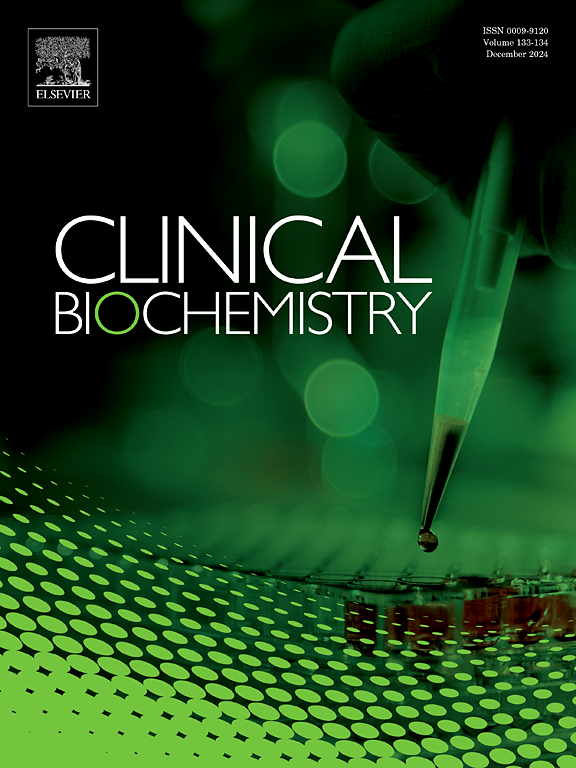Advancing cardiovascular risk assessment: Real-time SCORES2 calculation through CDSS in primary care patients
IF 2.1
3区 医学
Q2 MEDICAL LABORATORY TECHNOLOGY
引用次数: 0
Abstract
Background
Individualized cardiovascular risk stratification is recommended to guide treatment. The objective was to report the 10-year cardiovascular disease (CVD) risk in primary care patients without previous CVD or diabetes using the SCORE2 risk prediction algorithms, SCORE2 (age 40–69 years), and SCORE2-OP (age 70–89 years) scales, as per the European Society of Cardiology guidelines. The risk levels were categorized as low-moderate (<5 %), high (5–10 %), or very high (>10 %), with recommendations for treatment, through the clinical decision support system (CDSS).
Methods
A cross-sectional study was designed in collaboration with general practitioners.
The CDSS, integrated with computerized patient order entry, facilitated the calculation for CVD-free individuals after electronic medical record consultation. We counted the patients offered SCORES calculation, the number of acceptances and calculations, the results obtained, risk factors, along with adherence to recommended treatment.
Results
SCORES were offered to 971 patients, 635 SCORE2 and 336 SCORE2-OP, and 614 (96.7 %) SCORE2 and 160 (47.6 %). SCORE2-OP calculations were accepted, showing a significantly different acceptance rate. There was a significantly higher prevalence of smoking habit (P < 0.01) and hypertension (P < 0.01) among SCORE2 patients. Half of the SCORE2 patients were classified as low risk, more than 80 % of SCORE2-OP as high or very high risk. The adherence to treatment recommendations was 90.4 % overall, with a significant difference between SCORE2 (93.9 %) and SCORE2-OP (74.0 %) (P < 0.01).
Conclusion
The laboratory, in collaboration with clinicians and utilizing CDSS, plays a central role in clinical decision-making by reporting SCORE2 risk prediction algorithms and treatment recommendations.
推进心血管风险评估:通过 CDSS 对初级保健患者进行实时 SCORES2 计算
背景:个体化心血管风险分层被推荐用于指导治疗。目的是根据欧洲心脏病学会指南,使用SCORE2风险预测算法、SCORE2(年龄40-69岁)和SCORE2- op(年龄70-89岁)量表报告无既往心血管疾病或糖尿病的初级保健患者10年心血管疾病(CVD)风险。通过临床决策支持系统(CDSS),将风险等级分为中低(5%)、高(5 - 10%)和非常高(10%),并提出治疗建议。方法与全科医生合作设计横断面研究。结合电脑化的病人医嘱输入系统,电子病历会诊后,方便无心血管疾病人士的计算。我们统计了提供评分计算的患者、接受和计算的人数、获得的结果、危险因素以及对推荐治疗的依从性。结果对971例患者进行了评分,其中SCORE2 635例,SCORE2- op 336例,SCORE2 614例(96.7%),SCORE2 160例(47.6%)。接受SCORE2-OP计算,接受率有显著差异。吸烟习惯的患病率明显较高(P <;0.01)和高血压(P <;0.01)。一半的SCORE2患者被分类为低风险,超过80%的SCORE2- op被分类为高或非常高风险。总体而言,治疗建议的依从性为90.4%,SCORE2(93.9%)和SCORE2- op(74.0%)之间存在显著差异(P <;0.01)。结论实验室与临床医生合作,利用CDSS,通过报告SCORE2风险预测算法和治疗建议,在临床决策中发挥核心作用。
本文章由计算机程序翻译,如有差异,请以英文原文为准。
求助全文
约1分钟内获得全文
求助全文
来源期刊

Clinical biochemistry
医学-医学实验技术
CiteScore
5.10
自引率
0.00%
发文量
151
审稿时长
25 days
期刊介绍:
Clinical Biochemistry publishes articles relating to clinical chemistry, molecular biology and genetics, therapeutic drug monitoring and toxicology, laboratory immunology and laboratory medicine in general, with the focus on analytical and clinical investigation of laboratory tests in humans used for diagnosis, prognosis, treatment and therapy, and monitoring of disease.
 求助内容:
求助内容: 应助结果提醒方式:
应助结果提醒方式:


